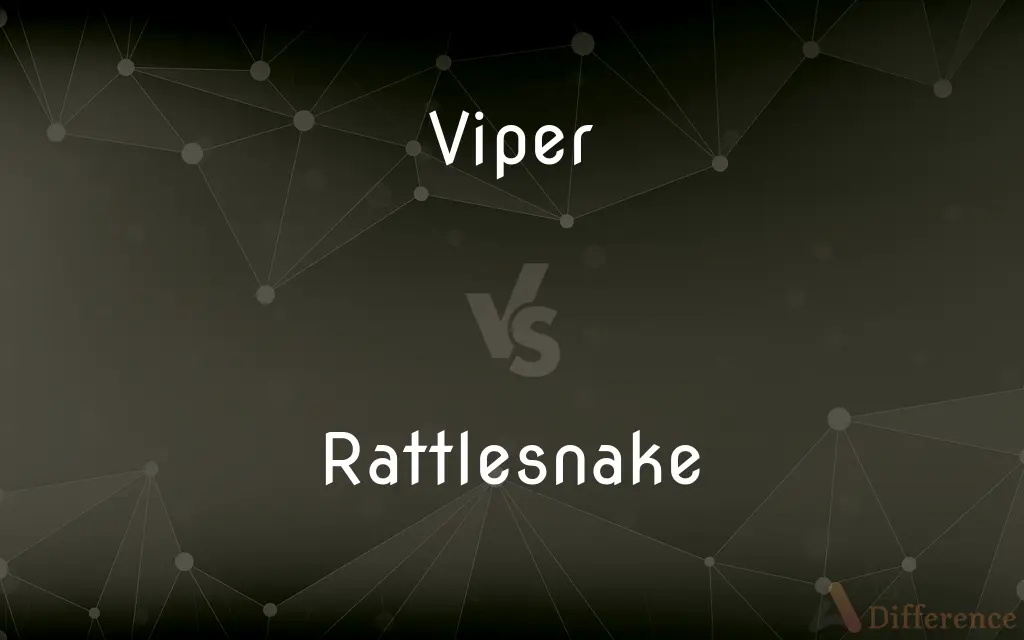Viper vs. Rattlesnake — What's the Difference?
By Maham Liaqat & Fiza Rafique — Updated on April 26, 2024
Vipers are a broad family of venomous snakes known for their long, hinged fangs, while rattlesnakes, a subgroup of vipers found mainly in the Americas, are distinguished by their unique tail rattle used as a warning.

Difference Between Viper and Rattlesnake
Table of Contents
ADVERTISEMENT
Key Differences
Vipers are a large family of snakes (Viperidae), characterized by their venom delivery system featuring long, hinged fangs that allow for deep penetration and efficient venom injection. Whereas rattlesnakes specifically are known for their distinctive tail rattle, which they use to warn potential threats before striking.
Vipers are found worldwide, particularly in Asia, Africa, and Europe, with diverse habitats ranging from deserts to forests. On the other hand, rattlesnakes are native to the Americas and primarily inhabit areas from southern Canada to central Argentina, often preferring dry, rocky terrains or scrubland.
The viper family includes several genera and species, varying greatly in size, color, and behavior. Conversely, rattlesnakes belong to the genus Crotalus and Sistrurus, and their behavior, such as rattling when threatened, is more uniform across species.
Most vipers are ambush predators, relying on their camouflage and patience to capture prey, which includes small mammals, birds, and insects. In contrast, rattlesnakes often exhibit similar hunting tactics but have an added advantage with their rattle to deter larger predators.
In terms of threat to humans, both vipers and rattlesnakes are dangerous due to their venom; however, rattlesnakes often give a warning with their rattle before striking, potentially reducing the likelihood of human fatalities.
ADVERTISEMENT
Comparison Chart
Family
Viperidae
Viperidae (subgroup: Crotalus and Sistrurus)
Fang Type
Long, hinged
Long, hinged
Habitat
Worldwide, diverse environments
Americas, mainly dry and rocky areas
Distinctive Feature
Venomous with effective venom delivery
Tail rattle for warning
Hunting Method
Ambush predators
Ambush predators, use rattle as a deterrent
Compare with Definitions
Viper
Members of the family Viperidae, diverse in size and habitat.
The habitat range of vipers includes forests, deserts, and mountains.
Rattlesnake
Uses its rattle as a deterrent before striking.
Before striking, the rattlesnake gives its characteristic rattle as a warning.
Viper
Characterized by a stocky body and triangular head.
The distinctive triangular head is a common feature of vipers.
Rattlesnake
A type of viper known for a rattle on its tail, which makes noise to warn off threats.
The rattlesnake shook its tail as we approached.
Viper
Noted for their potent venom, used to immobilize prey.
The venom of a viper can be deadly if not treated quickly.
Rattlesnake
Native to the Americas and known for its potent venom.
Rattlesnakes are common in the deserts of the southwestern United States.
Viper
A venomous snake with long, hinged fangs that allow deep venom injection.
The viper hid in the rocks, waiting for its prey.
Rattlesnake
Often seen basking in the sun on cool days.
The rattlesnake was basking on a sunny rock to warm up.
Viper
Found in various global regions except Australia and Antarctica.
Vipers are prevalent in both Asia and Africa.
Rattlesnake
Prefers dry, rocky areas where it can camouflage itself.
The rattlesnake blends into the rocky terrain, making it hard to spot.
Viper
Any of various venomous snakes of the family Viperidae, having a thick heavy body and a single pair of long hollow fangs, especially the Eurasian and African species of the subfamily Viperinae, which lack the sensory pits of the pit vipers.
Rattlesnake
Rattlesnakes are a group of venomous snakes of the genera Crotalus and Sistrurus of the subfamily Crotalinae (the pit vipers). The scientific name Crotalus is derived from the Greek κρόταλον, meaning "castanet".
Viper
Any of several harmless snakes sometimes believed to be venomous.
Rattlesnake
A heavy-bodied American pit viper with a series of horny rings on the tail that produce a characteristic rattling sound when vibrated as a warning.
Viper
A person regarded as malicious or treacherous.
Rattlesnake
Any of various venomous pit vipers of the genera Crotalus and Sistrurus of the Americas, having at the end of the tail a series of loosely attached, horny segments that can be vibrated to produce a rattling or buzzing sound.
Viper
A venomous snake in the family Viperidae.
Rattlesnake
Any of various venomous American snakes, of genera Crotalus and Sistrurus, having a rattle at the end of its tail.
Viper
(informal) Any venomous snake.
Rattlesnake
Any one of several species of venomous American snakes belonging to the genera Crotalus and Caudisona, or Sistrurus; sometimes also called rattler. They have a series of horny interlocking joints at the end of the tail which make a sharp rattling sound when shaken. The common rattlesnake of the Northern United States (Crotalus horridus), and the diamondback rattlesnake (also called diamondback rattler, and diamondback) of the South and East (Crotalus adamanteus) and West (Crotalus atrox), are the best known. See Illust. of Fang.
Viper
(figurative) A dangerous, treacherous, or malignant person.
Rattlesnake
Pit viper with horny segments at the end of the tail that rattle when shaken
Viper
(slang) A person who smokes marijuana.
Viper
Any one of numerous species of Old World venomous snakes belonging to Vipera, Clotho, Daboia, and other genera of the family Viperidæ.
There came a viper out of the heat, and fastened on his hand.
Viper
A dangerous, treacherous, or malignant person.
Who committedTo such a viper his most sacred trustOf secrecy.
Viper
Loosely, any venomous or presumed venomous snake.
Viper
Venomous Old World snakes characterized by hollow venom-conducting fangs in the upper jaw
Common Curiosities
Are rattlesnakes found outside the Americas?
Rattlesnakes are native only to the Americas, from Canada to Argentina.
What distinguishes a viper from other snakes?
Vipers are distinguished by their long, hinged fangs and potent venom.
How do vipers capture their prey?
Vipers typically use an ambush method, lying in wait to strike when prey comes close enough.
Can the venom of vipers be fatal?
Yes, viper venom can be fatal to humans if not treated promptly with the appropriate antivenom.
What adaptations help vipers survive in their environments?
Vipers have adaptations such as camouflaged skin and efficient venom delivery systems to help them survive.
Where can vipers be found?
Vipers are found worldwide, particularly in Asia, Africa, and Europe, in diverse habitats.
Do all vipers have the same type of venom?
While all vipers have venomous bites, the composition and potency of the venom can vary widely between species.
How do rattlesnakes contribute to their ecosystems?
Rattlesnakes help control populations of small mammals and pests, contributing to ecological balance.
What is the lifespan of a typical viper?
The lifespan of vipers varies, but many can live up to 20 years or more in the wild.
How does the rattle of a rattlesnake work?
The rattle of a rattlesnake is made of interlocking segments of keratin that create a rattling sound when vibrated.
Are vipers endangered?
Some viper species are endangered due to habitat loss, poaching, and other environmental pressures.
Why do rattlesnakes have rattles?
Rattlesnakes have rattles to warn potential threats of their presence, reducing the chance of conflict.
What should you do if you hear a rattlesnake rattle?
If you hear a rattlesnake rattle, you should slowly back away to avoid getting too close and provoking a strike.
What is the biggest threat to rattlesnakes?
The biggest threats to rattlesnakes include habitat destruction, road mortality, and deliberate killing by humans.
How fast can a rattlesnake strike?
A rattlesnake can strike at a speed of up to 2.5 meters per second, making it one of the fastest snake strikes.
Share Your Discovery

Previous Comparison
Relax vs. Chill
Next Comparison
Gadgety vs. GadgetAuthor Spotlight
Written by
Maham LiaqatCo-written by
Fiza RafiqueFiza Rafique is a skilled content writer at AskDifference.com, where she meticulously refines and enhances written pieces. Drawing from her vast editorial expertise, Fiza ensures clarity, accuracy, and precision in every article. Passionate about language, she continually seeks to elevate the quality of content for readers worldwide.














































